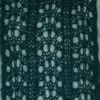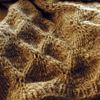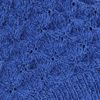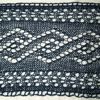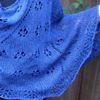
Frequently Answered Questions, added Oct 25, 2011: An M1 is Make 1, which means to take the little strand that connects the stitch you just knitted to the one coming up next and twist it to make a stitch. This adds one stitch without the hole a yarnover would give it.
Ssk means to slip a stitch as if you were going to knit it, slip the next one likewise, and then put the needle tip into the fronts of them from the left and knit them together that way. This makes a good mirror image of the height and slant made by knitting two together.
As for how much yarn to use: it varies tremendously, depending on weight of yarn, knitting gauge, and how big you want it. My husband is 6’8″ and I like afghans big enough to cover the toes and go up to the chin; therefore, using roughly an aran weight-spun but a relatively airy yarn for that thickness, I used nearly three pounds. Your mileage will definitely vary and there are no hard and fast rules, except for this: do a swatch of whatever yarn you want to work with, weigh it, and multiply the dimensions.
Note that this is more akin to a lace pattern than a cabled one: there are no overlapping stitches to help create the three-dimensional look, so the pattern will tend to flatten out once it’s wet, as lace does. If you knit it to a tight gauge with a merino or rambouillet yarn, ie the wools with the highest degree of crimp, the pattern will bounce back somewhat into the texture I find so delightful and that the camera showed well on my afghan.
Have fun!
—————
I knitted my Embossed Diamonds afghan in the colors of light reflecting off the sand at the beach, in oatmeal-colored superfine geelong lambswool I plied with undyed light brown cashmere on my spinning wheel. The back of the afghan looks to me like the patterns imprinted by the rain in the sand. The front reminds me of the patterns the tide divides into as the water thins and fans out over the beach–making me want to knit it again in shades of ocean blue, with perhaps a deeper k1p1 ribbing at the edges. It has even renamed itself already for it: Tidewater–and for a moment, the Chesapeake Bay reminds me that I have let the tides of life pull me far away. I lift the last of the yarn from the dyebath for it and it is ready to go. Click down to the rest of the story.
Pattern InstructionsMy gauge: two motifs=5.75″ across, unstretched. 10 st per motif plus 1, plus four ribbing stitches each edge of the afghan.Yarn: I used a cashmere/superfine lambswool yarn I’d six-plied from cones to make a yarn of about aran weight. Swatch with your own yarn to get the right fit between yarn and needles.
Needles: size 10 for body, size 8 for beginning and ending ribbing.
Cast on 159 (or 169, or 179, or 189, etc, depending on your gauge… you get the idea) on size 8s. Do p1, k1 ribbing across wrong side row to start. Rib for nine to twelve rows. I only did three the first time, and found it too short to counteract the tendency of the pattern to pull into a curl, and needed to redo it afterwards.
Wrong side rows: p1, k1, p1, k1, p across until the last four stitches, k1, p1, k1, p1.
Row 2: k1, p1, k1, p1, as the ribbing is already established at the sides, then k3, *k2tog, M1, k1, M1, ssk, k5; rep from *, end last repeat k3; then, p1, k1, p1, k1 at the far edge.
Row 4: k1, p1, k1, p1, k2, *k2tog, (k1, M1) twice, k1, ssk, k3; rep from *, ending k2, p1, k1, p1, k1.
Row 6: k1, p1, k1, p1, k1, *k2tog, k2, M1, k1, M1, k2, ssk, k1; repeat across, ending p1, k1, p1, k1.
Row 8: k1, p1, k1, p1, k2tog, *k3, M1, k1, M1, k3, sl1–k2tog–psso; rep from *, ending ssk on last repeat, then p1, k1, p1, k1.
Row 10: k1, p1, k1, p1, k1, *M1, ssk, k5, k2tog, M1, k1; rep across, p1, k1, p1, k1.
Row 12: k1, p1, k1, p1, k1, *M1, k1, ssk, k3, k2tog, k1, M1, k1, rep across, p1, k1, p1, k1.
Row 14: k1, p1, k1, p1, k1, *M1, k2, ssk, k1, k2tog, k2, M1, k1; rep across, p1, k1, p1, k1.
Row 16: k1, p1, k1, p1, k1, *M1, k3, sl1–k2tog–psso, k3, M1, k1; rep across, p1, k1, p1, k1.
At the end, switch back to size 8s and do k1, p1 ribbing across to match the beginning of the afghan. I like my afghans long; it needs
to cover the feet and go up to the chin to be truly useful on a chilly evening.
The Delmarva Peninsula beaches I remember from my childhood come in bright, long, flat expanses of warm sand that invite the summer hurricanes to sweep on over them. Chincoteague and Assateague Islands are a bit offshore, the one being peopled, the other being preserved parkland with supposedly wild ponies roaming it. Which means they amble from campsite to campsite of vacationers, begging for attention and perhaps a carrot. There is a legend of a sunken Spanish ship, and that only the horses survived, their descendents roaming the island; I have no idea if it’s true. But the ponies are there. Except on those days the self-called saltwater cowboys round them up, making them swim across to Chincoteague, adopting out some of the herd to keep the population manageable. Pony Penning Day–go see http://www.chincoteague.com. An old tradition, a place of old histories and ways of living.
Where we live now, south of San Francisco, the beaches for the most part are cold, rocky and short, with cliff faces straight up just back from the water. There are outcroppings that pass for islands, dark boulders heaped on boulders; a few tourists get swept away every year after going out when the tide is low, thinking they’re safe. They’re not. But here and there are sandy areas it’s okay to explore, closer in; the tidepools are overflowing with life, and always, there is the fog, cooling the summers, softening the colors, obscuring the distance.
After seventeen years here I still can’t quite shake the feeling that the sun is supposed to rise rather than set at the ocean. It’s supposed to signal the brightness of a new day–after all, isn’t that what so many people come to California hoping to find?
I have gathered small seashells, examined the way ocean turbulence and predators have changed them–seen the broken edges, the holes piercing the pearled smoothness of their inner surfaces–and put them back for the next soul to see that they are beautiful, still. And a bit of sand stays in the shoes no matter how much I shake them out, always; some things do stay the same after all, coast to coast, change to change.
Our house is forty minutes or so inland, near the San Francisco Bay. We put in a new walk coming to the front entryway, nine years ago, and the contractor poured a decorative layer of pebbles into the wet concrete. He made a point of telling me, in case I should ever want more, for, say, a new back patio or something, that the pebbles came from a lot named Terry Beach. He knew about my knitting by then; I teased him, “You mean beaches come in dye lots?” Is there such a thing as rock lots? I guess there is. And now a bit of the Pacific comes right up to my door. On the eastern side of the house, so it sees the sun first.
My lambswool and cashmere sand I left the colors it came in, my yarn-water-to-be is now in shades of indigo. Here’s the pattern.
© Copyright Alison J. Hyde 2004, 2005, 2006, and 2007. All rights reserved.
Note to yarn store owners, there having been problems with copyright violations: you do not have my permission to print out copies of my patterns in your stores. Individuals only may print out copies at home for their own private and personal use. Questions may be addressed to me at spindyeknit AT gmail DOT cahm.
